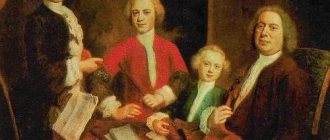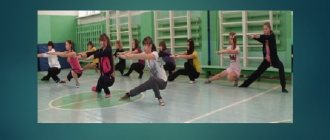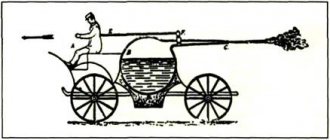Specifics of Russian Baroque
MUNICIPAL BUDGET EDUCATIONAL INSTITUTION
"ROVDINSKAYA SECONDARY EDUCATION SCHOOL"
Discipline – World artistic culture (Art)
Topic: “Specifics of Russian Baroque”
Textbook - L.G. Emokhonova. MHC textbook for grade 11. Moscow. Publishing, 2009
Class (course) – 11
Lesson duration: 45 minutes
(lesson using Microsoft Office PowerPoint 2007 presentation)
Author - Sitnikova Yulianna Vasilievna
Qualification category - first
Place of residence: the village of Rovdino, Shenkursky district, Arkhangelsk region
Lesson format:
combined lesson.
Target:
developing in students the ability to emotionally and personally perceive and comprehend the features of Rastrelli's Baroque.
Tasks:
- Expanding the cultural and artistic horizons of students when getting acquainted with Russian Baroque.
- Developing in students the ability to personally experience the work of art being studied, as well as the ability to analyze, systematize and critically comprehend the material.
- Comprehension of the ideological accents of the work of the Russian architect F.B. Rastrelli.
Visual range:
General view and interiors of the Winter Palace in St. Petersburg and the Catherine Palace in Tsarskoe Selo, portrait of Francesco Bartolomeo Rastrelli, photographs of panoramas of St. Petersburg, amateur photographs taken during a tour of St. Petersburg.
Videos:
Facades of the Winter Palace, Catherine Palace.
Equipment:
multimedia projector, screen, laptop.
Methods:
- Emotional-imaginative immersion;
- Holistic impact of the arts;
- Activation of perception, imagination and creative thinking;
- Creating situations of creative search;
- Formal analysis of works of art.
Form of study:
group and individual educational, cognitive and creative activities.
During the classes.
I. Organizational moment.
When studying the topic of Baroque, I would like to pay special attention to the specifics of Baroque in Russia. The Russian national feature of this style has a unique beauty and charm. For thousands of years, people have been dreaming of paradise - heavenly and earthly. The earthly paradise should resemble the heavenly one and relate to it. A person looks for it in the beauty of landscapes or creates it himself. Art—architecture, architecture—has long been engaged in the correlation and conjugation of the earthly and the heavenly. It is no coincidence that the word “architect” itself means “chief builder”, “supreme builder”.
It is no coincidence that architecture is called frozen music. She plays with space and light. Man has never lived outside of architecture, he always lives inside it .
Architecture is a kind of book that people have been writing for centuries, subordinating it to national customs and visions. Architecture organizes the space of the cities in which we live, making them original and unique. Many architectural structures become the calling cards of cities; the more interesting and original the urban environment is organized, the brighter and more original the city itself.
II. Main part
- “Architectural core of the city” (work with the map of St. Petersburg)
Today we will take you on a virtual tour of one of the majestic cities of Russia - St. Petersburg, based on video material and impressions that you had during a real visit to the city.
On the screen is a panorama of the Neva, Hare Island, the spit of Vasilyevsky Island, Palace Square and Admiralteysky Boulevard (Slide 2-3).
- Consider the plan of the historical part of St. Petersburg and identify the characteristic features of the city's layout.
- What do you think the local landscape has in common?
We will find confirmation of our thoughts in the textbook: “The main “avenue” and the main “square” of the new capital, founded at the mouth of the Neva, was the river. It compositionally united the local landscape - flat marshy shores and vast expanses of water. All major architectural ensembles were grouped around the Neva.” ( textbook, p. 75).
“Building St. Petersburg as a European city” (introduction to the research topic)
Students look at the panorama of the Neva, Hare Island, the spit of Vasilyevsky Island, Palace Square and Admiralteysky Boulevard.
From his youth, Tsar Peter I dreamed of a new Russian capital on the seashore, a capital that would resemble Western European cities. That is why, as soon as he founded St. Petersburg, the sovereign ordered all ambassadors to look for and hire experienced craftsmen, artists, and architects in the West.
On the screen is a portrait of Francesco Bartolomeo Rastrelli. (Slide 4)
Francesco Bartolomeo Rastrelli was the same age as you are now when he, the son of an Italian sculptor, came to Russia with his father and stayed here forever.
“He transformed St. Petersburg from a fortified city, a port city, into a city of palaces. The ensembles created by him - the Winter Palace and the Smolny Monastery in St. Petersburg, the Catherine Palace in Tsarskoe Selo - belong to a unique style that has no analogues in the West, —
Rastrelli's baroque, or monumental rococo"
(textbook, p. 76).
It should be noted right away that the chronological framework of the Baroque style in Russia and in Europe does not coincide. The Baroque style, which developed in Europe in the 17th century, entered Rus' only at the end of the century. The new architectural style in Rus', called “Naryshkin Baroque,” was very different from the Western prototype. The national craving for patterns and rich colors led to the use of lush floral decoration even in religious construction and the combination of red brickwork with carved details made of white stone (Slide 5).
The “Petrine Baroque” style, which took shape during the construction of St. Petersburg and country palaces, absorbed the graphic nature of Dutch architecture, the lush decorativeness of the “grand style” of Louis XIV and the sophisticated linearity of Italian mannerism. But the Baroque style received truly large-scale development in the Elizabethan era, when St. Petersburg turned from a port city into a city of palaces. It was the Rococo ornamentation, combined with the classical order, Baroque dynamics and Russian patterning, that became the core of the unique Russian Baroque, which Rastrelli masterfully incorporated into the unique St. Petersburg landscape (Slide 6).
Today we will take a fascinating journey through the most outstanding and famous architectural ensembles of Francesco Bartolomeo Rastrelli, exploring the features of his original style, and will try to perform a formal analysis of works of architecture.
- "Main features of the architecture of the Catherine Palace"
Video fragment “Catherine's Palace”
““Paphos of width” in the architecture of the royal residence in Tsarskoe Selo” ( textbook, p. 78).
Now look at the illustrations and try to find the construction and decorative techniques of the architect that he used during the construction of the Catherine Palace. (Slides 7-10).
The master’s original findings include the solution to the interior space of the palace (Slide 11-15)
- Questions to Consider (Slide 16)
Supplement your research and reflections with the text of the textbook (pp. 78 - 79), draw conclusions and generalizations.
- «Main features of the architecture
Winter Palace"
In front of you is the Winter Palace, one of the most remarkable creations of Francesco Bartolomeo Rastrelli. Pay attention to the facades of the palace.
Video fragment “Facades of the Winter Palace”
Analysis of the architectural features of the design of the facades of the Winter Palace together with students (Slides 17 -22).
Let's try to find answers to the following questions (Slide 23):
- What techniques did the architect use to overcome the weight of the stone mass and create the illusory mobility of the wall?
- How is the issue of confrontation between horizontal and vertical resolved in the architecture of the Winter Palace?
- What is unique about the architecture of the Winter Palace?
Research assignment “Stylistics of Rastrelli’s Baroque” (Slide 24)
Students look at images of Baroque architecture projected onto a screen.
To get a clearer feel for the style of Rastrelli’s baroque, let’s complete a small task.
• Consider the architectural structures of the Baroque era. Determine the similarities and differences between the Italian and Rastrelli baroque.
Answers, thoughts of the guys.
- Analysis of the architectural ensemble of the Great Peterhof Palace (project by F.B. Rastrelli).
Determine the stylistic features of the Elizabethan Baroque using the example of the architectural and park ensemble of the Great Peterhof Palace (Slides 25-37). Students work together with the teacher (based on materials from a real excursion)
- Features of the architectural and park ensemble (Upper and Lower parks).
- Purpose and function of the structure.
- Light organization of the facades and interior space of the palace.
- Color.
- Relationship with sculpture and monumental painting.
- Temporal organization of the perception of a structure and the life taking place in it.
III. Conclusion
Today, contemplating the architectural ensembles of Francesco Bartolomeo Rastrelli, reflecting on them and exploring them, we jointly analyzed Rastrelli’s works, which reflected the most important features of a unique style - Russian Baroque.
Homework:
§eleven. Get acquainted with the architectural features of the Smolny Monastery.
Thanks for the work. Goodbye!
Literature.
- L.G. Emokhonova. MHC textbook for grade 11. Moscow. Publishing, 2009
- L.G. Emokhonova, N.N. Malakhova. MHC book for 11th grade teachers. Moscow. Publishing, 2009
- CD supplement to the MHC textbook for grade 11
- Video tour “St. Petersburg and its suburbs.” AMFORA video company
Lesson summary on MHC "Baroque in Architecture"
Lesson 3 11th grade Baroque in architecture
The predecessor of the Baroque, the Great Michelangelo, with the power and expression of his individual style, instantly destroyed all the usual ideas about the previous “rules” of drawing and composition. The powerful figures he painted on the ceiling of the Sistine Chapel visually “destroyed” the pictorial space allocated for them; they did not correspond either to the script or to the space of the architecture itself. Everything here was anti-classical. G. Vasari, the famous chronicler of the Renaissance, amazed, like others, called this style “bizarre, extraordinary and new.” Other works by Michelangelo: the architectural ensemble of the Capitol in Rome, the interior of the Medici Chapel and the vestibule of the Library of San Lorenzo in Florence - demonstrated classicist forms, but everything in them was covered with extraordinary tension and excitement. Baroque is the first style of architecture that embodies the idea of the complexity of the world, the essence of life in the movement and struggle of random and spontaneous forces. Baroque leads art to irrationality, to mysticism, influences the imagination with the image of powerful forces of nature, gigantic compositions, depth of space, the contrast of the small and the grandiose. The Baroque artist prefers to depict scenes of torment, ecstasy, panegyrics, exploits and triumphs. Rome becomes the center of the Baroque; the Catholic reaction to the Reformation leads to the search for new means of influencing believers. Baroque temples are grandiose, complex, the art is monumental and elevated. Sculpture and architecture once again enter into a complex relationship of synthesis. Colorful paintings decorate the lampshades, domes, and walls. The illusion of vast space is created. Nature is included in the architectural ensemble. Squares and streets are united with the help of colonnades, terraces, sculptures and cascades. The layout of squares and cities is designed for the masses of people. In Baroque architectural forms, preference is given to curvilinear outlines, and the plastic and picturesque interpretation of architecture is enhanced. Straight lines are replaced by curvilinear, curved, rounded, writhing ones. The undulating façade, decorative sculpture, deep niches, and the restless rhythm of the windows are all features of the Baroque. A large place is occupied by palaces, elegant, magnificent, surrounded by wings. The villas are located on terraces running down, surrounded by gardens. Baroque temples are grandiose, reminiscent of palaces. Features of Baroque (in a notebook) Baroque is characterized by contrast, tension, dynamism of images, affectation (excessive expression of feelings). In Baroque works there is a desire for grandeur and splendor, for a combination of reality and illusion, for a fusion of arts (city and palace and park ensembles). Baroque architecture (L. Bernini, F. Borromini in Italy, B. Rastrelli in Russia) is characterized by spatial scope, unity, and fluidity of complex, usually curvilinear forms. Often there are large-scale colonnades, an abundance of sculpture on the facades and in the interiors, volutes, a large number of braces, arched facades with bracing in the middle, rusticated columns and pilasters. Domes take on complex shapes, often multi-tiered, like those of St. Peter's Cathedral in Rome. Characteristic Baroque details - telamon (Atlas), caryatid, mascaron.
The Baroque style became widespread in Spain, Germany, Belgium (then Flanders), the Netherlands, Russia, and France. Spanish Baroque, or locally known as Churrigueresco (in honor of the architect Churriguera), also spread to Latin America. Its most popular monument is the Cathedral in Santiago de Compostela, which is also one of the most revered churches in Spain. In Latin America, Baroque mixed with local architectural traditions, this is its most elaborate version, and it is called ultra-baroque. In France, the Baroque style is expressed more modestly than in other countries. Previously, it was believed that the style did not develop here at all, and Baroque monuments were considered monuments of classicism. The term “Baroque classicism” is sometimes used in relation to the French and English versions of the Baroque. Now the Palace of Versailles along with the regular park, the Luxembourg Palace, the building of the French Academy in Paris and other works are considered to be French Baroque. They do have some classicist features. Also in England, here the works of the architect Inigo Jones and others belong to this style. A characteristic feature of the Baroque style is the regular style in landscape gardening art, an example of which is the Park of Versailles. In Belgium, the outstanding Baroque monument is the Grand Place ensemble in Brussels. Rubens' house in Antwerp, built according to the artist's own design, has Baroque features. In Germany, the outstanding Baroque monument is the New Palace in Sans Souci (authors: I. G. Bühring, H. L. Manter) and the Summer Palace there (G. W. von Knobelsdorff). The largest and most famous Baroque ensembles in the world: Versailles (France), Petrodvorets (Russia), Aranjuez (Spain), Zwinger (Germany).




